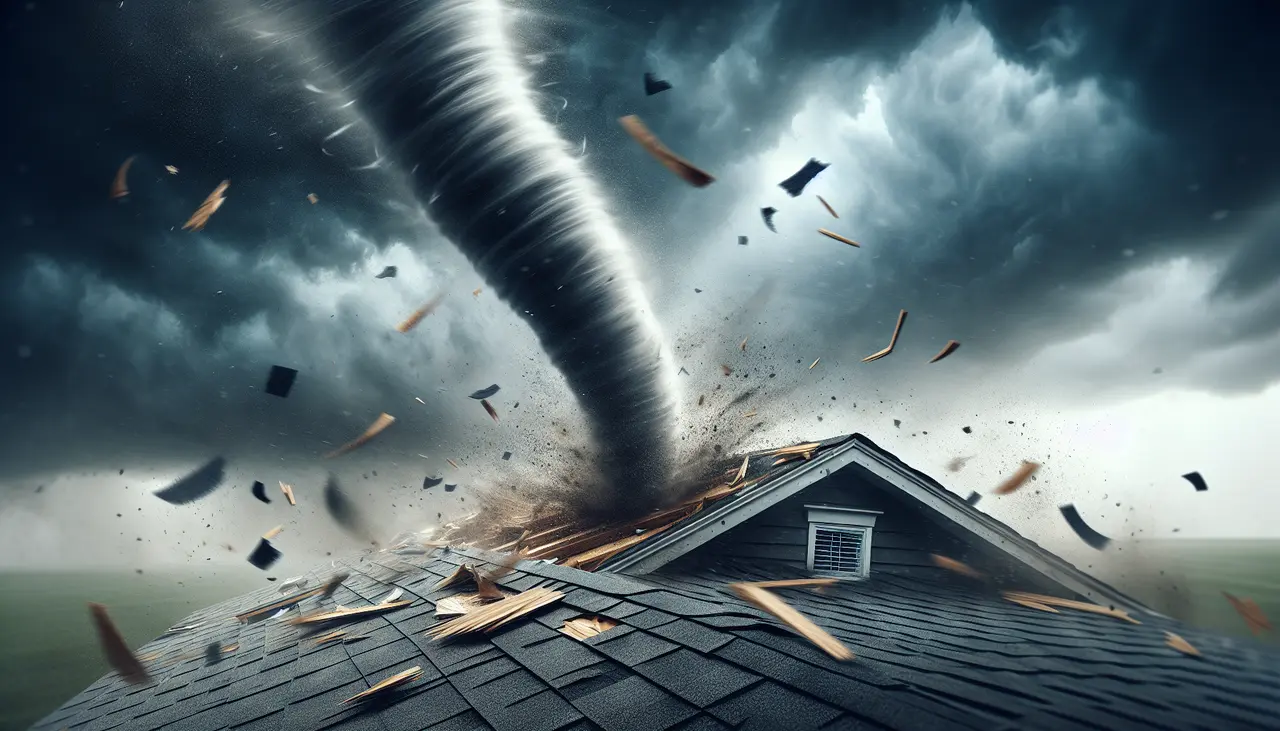Experiencing a tornado can be a traumatic event, and the aftermath can leave you wondering if your home has sustained any damage. One of the most vulnerable parts of your home during a tornado is the roof. Identifying damage early on can save you time, money, and further headaches. In this blog, we’ll guide you through the signs of tornado damage to look for on your roof.
Missing or Torn Shingles
After a tornado, one of the most common signs of damage is missing or torn shingles. These can leave your roof exposed to the elements, leading to leaks and structural damage.
It’s essential to inspect your roof for shingles that may have been completely blown off or are hanging loose. Missing shingles are particularly obvious, often scattered around your yard or neighboring areas. Torn shingles, however, may still be attached but will show visible signs of wear, such as tears and curling edges.
Shingles torn just slightly can still compromise the waterproofing of your roof. These small tears may appear insignificant but allow water to seep through, causing potential damage to your roof’s underlayment.
If your roof has missing shingles, it’s a sign that the integrity of your home’s defense system is weakened. Strong winds can easily lift and remove shingles, setting the stage for more severe damage if not addressed promptly.
Visible Indentations or Dents
Hail, a frequent companion of tornadoes, can leave indentations or dents on your roof. These may not seem severe at first but can weaken the roofing material over time.
Indentations on shingles, metal vents, and flashing are common after a hailstorm. These dents might not be immediately apparent, especially from the ground. You may need to climb up onto the roof or use a ladder to inspect these areas closely.
Be sure to check your gutters and downspouts for dents as well. If there are dents in the gutters, there’s a good chance that your roof has experienced similar impacts. Dents more than an inch in diameter are especially concerning and certainly indicate a need for further inspection.
Dented or damaged components can lead to water pooling and other issues if left unaddressed. Consulting a professional to assess the damage might be the best course of action if you’re not comfortable inspecting the roof yourself.
Damaged Flashing and Gutters
Check the flashing around chimneys, vents, and skylights, as well as your gutters. Tornadoes can easily bend or tear these components, compromising your roof’s ability to channel water away properly.
Flashing is designed to direct water away from critical areas of your roof. When it’s damaged, water can infiltrate these areas, causing leaks and potentially extensive structural damage. Look for signs such as cracks, lifting, or missing flashing.
Gutters and downspouts also play a crucial role in your roof’s drainage system. Tornadoes can cause gutters to detach from the house or become clogged with debris. Damaged gutters may not be immediately visible, but water spilling over the sides during rain is a telltale sign.
Properly functioning gutters help keep water away from your home’s foundation, hence their importance can’t be overstated. If you find any damage, it’s prudent to repair or replace these damaged parts to ensure the longevity of your roof and the safety of your home.
Sagging Roofline
A sagging roofline can indicate severe structural damage. This is a serious issue that requires immediate professional attention to ensure the safety of your home.
A roofline that appears uneven or dips in certain areas is a cause for concern. This sagging often means that the underlying structure, such as the rafters or trusses, has been compromised.
Heavy winds and the force of a tornado can apply immense pressure on the roof, causing structural shifts and damage. Not addressing this issue promptly can lead to further deterioration, potentially making the home uninhabitable.
You can use a level or a straight edge to check for any deviations in the roofline. Any irregularities should prompt you to call an expert for a more detailed assessment and necessary repairs.
Debris on the Roof
After a tornado, debris such as tree branches, leaves, and other materials can be scattered across your roof. This debris can cause additional damage if not removed promptly.
Debris can puncture your roofing material, especially if sharp or heavy objects are involved. Tree limbs and branches can be particularly destructive, potentially creating holes or dents.
In addition to causing physical damage, accumulated debris can hold moisture against your roof, accelerating wear and potential for leaks. It’s important to address this promptly by safely removing the debris or hiring a professional to do so.
Regular cleaning of debris not only extends the life of your roof but also makes it easier to spot other forms of tornado damage, helping you maintain the overall health of your home.
Leaks Inside the Home
Water stains or leaks on your ceilings and walls are clear indicators of roof damage. If you notice these signs, it’s crucial to inspect your roof for potential damage points.
Leaks can be caused by various forms of damage such as missing shingles, broken flashing, or punctures from debris. Identifying the source of the leak as soon as possible is essential to preventing further water damage within your home.
Keep an eye on the attic as well, as this is often the first place signs of water intrusion will appear. Water stains, damp insulation, and even mold are strong indicators that your roof is leaking.
Addressing the problem from inside the house can buy you some time, but the root cause has to be repaired on the exterior to ensure a permanent solution. It’s always best to consult a professional to deal with roof leaks effectively.
Loss of Granules
Granules provide an essential protective layer on asphalt shingles. If you observe an excessive amount of granules in your gutters or downspouts, it might be a sign that your roof has suffered significant damage.
Granules are designed to protect your shingles from UV rays and improve fire resistance. When they start to disappear, the asphalt layer underneath is exposed, which can lead to faster deterioration.
Regularly check your gutters and the ground below downspouts for accumulated granules. While some granule loss over time is normal, an excessive amount following a tornado is usually a sign of harm.
If granule loss is detected, consider inspecting the shingles closely for other damage such as cracks or missing chunks. This could be an early sign that your roof needs more significant repairs or even replacement.
Take Action Quickly
Identifying tornado damage on your roof as soon as possible can make a significant difference in preserving the safety and integrity of your home. If you notice any of these signs, it’s important to contact a professional to assess and repair the damage. Remember, acting promptly can prevent minor issues from becoming major problems.


